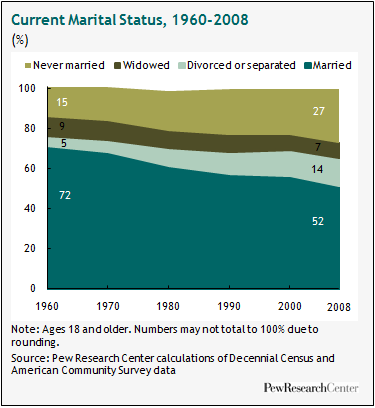
Over the past 50 years, a quiet revolution has taken place in this country. Decades of demographic, economic and social change have transformed the structure and composition of the American family. The pre-eminent family unit of the mid-20th century—mom, dad and the kids—no longer has the stage to itself. A variety of new arrangements have emerged, giving rise to a broader and evolving definition of what constitutes a family.
At the center of this transformation is the shrinking institution of marriage. In 1960, 72% of American adults were married. By 2008, that share had fallen to 52%.
Part of this decline is explained by the fact that the average age at which men and women first marry is now the highest ever recorded, having risen by roughly five years in the past half century.1 And part of the decline is attributable to the near tripling in the share of currently divorced or separated—to 14% in 2008 from 5% in 1960.2
Public attitudes toward marriage reflect these dramatic changes. When asked in the new survey if marriage is becoming obsolete, about four-in-ten Americans (39%) say that it is. In a survey of voters conducted by Time magazine in 1978, when the divorce rate in this country was near an all-time high, just 28% agreed that marriage was becoming obsolete.3
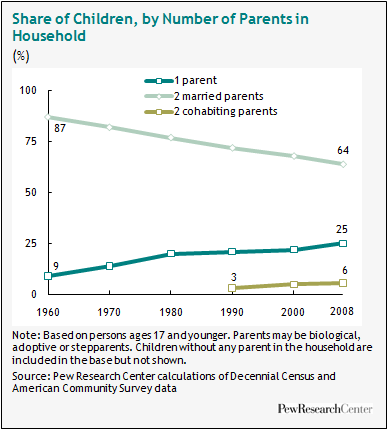
Changes in marital patterns have had a major impact on the lives of children in this country. Marriage is no longer considered a prerequisite for parenthood. Over the past 50 years, the share of children born to unmarried mothers has risen dramatically—increasing eightfold from 5% in 1960 to 41% in 2008.This trend has contributed to the decrease in the share of children under age 18 living with two married parents – to 64% in 2008 from 87% in 1960.4
There are distinctive socio-economic, generational and racial patterns in the trends away from marriage and toward single parenthood and other emerging family forms.
Marriage rates are now more strongly linked to education than they have been in the past, with college graduates (64%) much more likely to be married than those who have never attended college (48%).
The racial differences are even larger. Blacks (32%) are much less likely than whites (56%) to be married, and this gap has increased significantly over time. And black children (52%) are nearly three times as likely as white children (18%) and nearly twice as likely as Hispanic children (27%) to live with one parent.
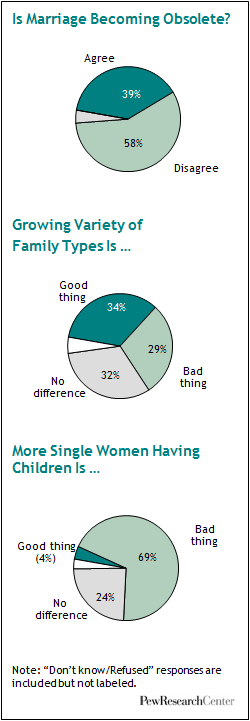
As the country shifts away from marriage, a smaller proportion of adults are experiencing the economic gains that typically accrue from marriage. In 2008, the median household income of married adults was 41% greater than that of unmarried adults, even after controlling for differences in household size.5 In 1960, this gap was only 12%. The widening of the gap is explained partly by the increased share of wives in the workforce (61% in 2008 versus 32% in 1960) and partly by the increased differential in the educational attainment of the married and the unmarried.6
The net result is that a marriage gap and a socio-economic gap have been growing side by side for the past half century, and each may be feeding off the other. As will be shown in greater detail in Chapter 2, adults on the lower rungs of the socio-economic ladder (whether measured by income or education) are just as eager as other adults to marry. But they place a higher premium on economic security as a prerequisite for marriage than do those with higher levels of income and education. And this is a bar that they—and their pool of prospective spouses—may find increasingly difficult to meet, given the fact that, relative to other groups, they have experienced significant economic declines in recent decades.
The changes in marriage rates are driven in large part by the behavior and attitudes of young adults, who are both delaying marriage and entering into less-traditional family arrangements. In 1960, 68% of adults ages 20-29 were married. By 2008, only 26% were married. The fact that young adults are delaying marriage does not necessarily mean they will never marry. Only time will tell. Meantime, it’s still the case that the vast majority of adults in the U.S. eventually get married. Among those ages 45 and older roughly nine-in-ten have ever married.
That said, young adults do have much different attitudes toward the trends that are driving family change. Nearly half of those under age 30 (46%) say the growing variety of family arrangements is a good thing, compared with just 30% of those ages 30 and older. In addition, young adults are much more accepting than their older counterparts of a host of societal trends affecting families, from more people living together without getting married to more gay and lesbian couples raising children.
Public Reactions to Decades of Change
The public is aware of the changes in marriage and family that have taken place over the past 50 years—and accepts some more readily than others. There is no clear consensus on the overall merit of the rise of new family arrangements. When asked whether the growing variety in the types of family arrangements is a good thing, a bad thing or doesn’t make a difference, the public is evenly split. A third (34%) say it’s a good thing, 29% say it’s a bad thing and 32% say it doesn’t make a difference.
Where you stand on this issue depends to some degree on how you live. Adults who are living a more traditional family life—married with children—are among the most resistant to the growing variety of family arrangements: 38% say it is a bad thing. Those who are divorced or separated have more of a live and let live attitude: a 39% plurality say the changes don’t make a difference. Those who are living with a partner are largely supportive of the new arrangements: a 56% majority says the growing variety is a good thing.
Of all the changes in family structure, the one that draws the strongest negative reaction is single parenthood. An overwhelming majority (69%) say the trend toward more single women having children without a male partner to help raise them is a bad thing for society. And a majority (61%) still believe that a child needs both a mother and a father to grow up happily.
Other changes get a much better reception from the public. For example, more than six-in-ten (62%) now say that the best kind of marriage is one where the husband and wife both work and both take care of the household and children. In 1977, fewer than half (48%) endorsed this egalitarian template for spousal roles.
And the public is quite open to the idea that marriage need not be the only path to family formation. An overwhelming majority says a single parent and a child constitute a family (86%), nearly as many (80%) say an unmarried couple living together with a child is a family, and 63% say a gay couple raising a child is a family.
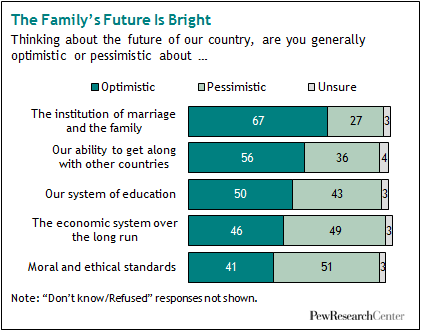
In the midst of all this change, the public maintains a positive outlook about the future of the family. When asked if they feel generally optimistic or pessimistic about the institution of marriage and the family, 67% say they are optimistic, 27% are pessimistic and 6% are unsure.
Respondents were asked about the future of various dimensions of national life, in addition to the family—moral and ethical standards, the long-term soundness of our economic system, our ability to get along with other nations and our system of education. Family came out on top. A narrow majority expressed optimism about the ability of the United States to get along with other countries (56% optimistic). The public was much more evenly divided over the future prospects of the educational system, the economy, and morals and ethics.
This generally upbeat view of the family can be seen across major demographic groups. Men and women, whites and blacks, young and old, and affluent and lower income adults all express high levels of optimism about the future of marriage and the family. This is notable, because these groups differ sharply in their assessments of the specific trends that have affected the family and in their own family arrangements. Married adults are somewhat more positive than unmarried adults about the future of marriage and the family. Even so, majorities in each group say they are generally optimistic about the family’s future.
Family Remains Central, Satisfying
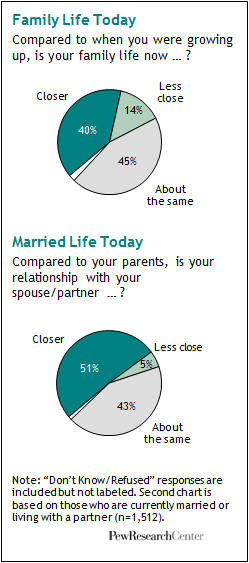
While the structure and composition of the family have changed, the importance of family has not been diminished in the process. The modern family, in all its forms, is highly valued and remains a source of great satisfaction for the vast majority of Americans. Three-quarters of all adults (76%) say their family is the most important element of their life at this time. An additional 22% say it is one of the most important elements but not the most important. Only 1% say their family is not an important element of their life.
In addition, family life remains highly satisfying for most Americans. Three-quarters are very satisfied with their family life, and 19% are somewhat satisfied. Fewer than one-in-ten (6%) are dissatisfied with this aspect of their life. In general, family life is considered more satisfying than social life, community life or career.
And there doesn’t seem to be much yearning for the good ol’ days. Survey respondents say their families today are at least as close as the families in which they grew up. When asked to make this comparison, 40% say their family today is closer, 45% say it’s about the same and 14% say their family is less close now than when they were growing up.
Similarly, among respondents who are married or living with a partner, half (51%) say they have a closer relationship with their spouse or partner than their parents had with each other. An additional 43% say their relationship is about the same as their parents’ relationship. Only 5% describe their relationship with their spouse or partner as less close.
Family in the New Economy
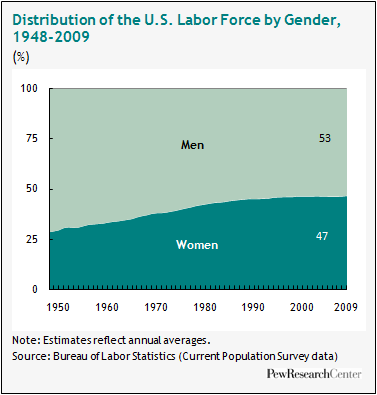
Changes in demographics are not the only factor driving family change. Over the past 50 years, the U.S. economy has been transformed on several dimensions. The manufacturing-based economy has been replaced by an information-based economy. And the presence of women in the workplace has increased dramatically. In 1960, women comprised only 33% of the U.S. labor force. By 2009, women had reached near parity with men (47% of the workforce).
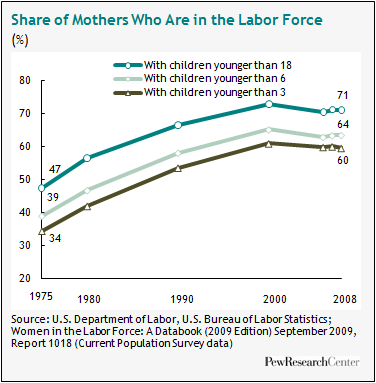
Over that same period, women have made significant gains in educational attainment. In 1960, less than 6% of women had a college degree. By 2008, that share had climbed to 29%. Furthermore, for the past two decades, women have been the majority of new college graduates. As a result, among adults in their 20s and 30s today, more women than men have graduated from college.
These dramatic changes in the economic status of women have had wide-ranging effects on family structure. In the 1950s and 1960s, most married women did not work outside the home, instead relying on their husbands’ income to support the family. In 1960, 32% of wives were in the labor force. By 2008, that share had risen to 61%.7
Along with their greater participation in the labor force, women began to delay marriage and have fewer children. In addition, women have been faced with the challenge of balancing marriage, motherhood and work. A large majority of mothers with children younger than 18 (71%) are now in the labor force. In 1975, fewer than half of all mothers were working. Even among mothers of very young children (younger than 3), 60% are in the labor force, up from 34% in 1975.
In spite of the gains women have made in the educational arena and in the workplace, most of the public adheres to a fairly traditional view of which spouse should be the primary breadwinner. When asked in the current Pew Research Center survey how important it is that a woman be able to support a family financially in order to be ready for marriage, only 33% say this is very important. When asked a parallel question about men, 67% say it is very important that a man be able to support a family.
Changing Values and Changes in Family
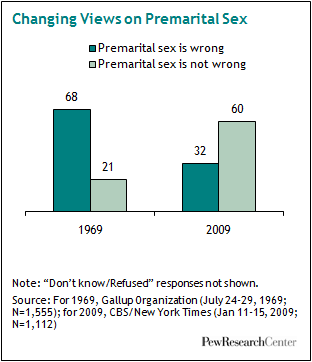
With the arrival of the birth control pill in the early 1960s, American women gained a new measure of control over their reproductive lives. Public attitudes about sex outside of marriage have changed dramatically since that time. According to polling conducted by the Gallup Organization in 1969, more than two-thirds of the public (68%) believed that it was wrong for a man and woman to have sexual relations before marriage; only 21% thought this was not wrong. By 1985, the balance of opinion had shifted significantly: 39% said sex before marriage was wrong, while a narrow majority (52%) said it was not. In a 2009 CBS/New York Times poll, the public more decisively rejected the idea that sex before marriage was wrong—only 32% said it was wrong; 60% said it was not.
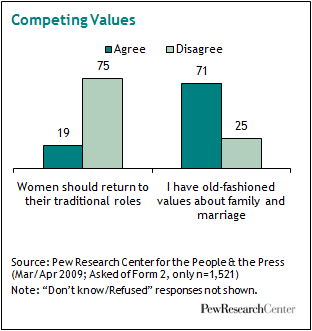
The Pew Research Center has been tracking social and political values for more than 20 years. The data show the public’s ambivalence about changing gender roles over the past half century. While the public now clearly embraces the changing role of women in society, most Americans still maintain a more traditional orientation toward family and marriage. When asked in 2009 whether they agreed or disagreed that women should return to their traditional roles in society, only 19% of adults agreed while 75% disagreed. At the same time, 71% said they have old-fashioned values about family and marriage. Only 25% disagreed with this statement.
There has been some shift in attitudes on these questions over the past 20 years: In 1987, 30% of adults (vs. 19% in 2009) said women should return to their traditional roles in society. Similarly, 87% agreed that they had old-fashioned values about family in 1987 (vs. 71% in 2009).
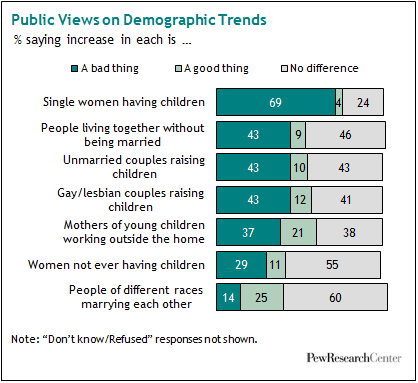
Within the framework of these competing values, the public has mixed reactions to the major demographic trends that have transformed family life in recent decades. In the current survey, the one trend that elicits the most negative reaction from the public is the increasing number of single women having children without a male partner to help raise them. Roughly seven-in-ten (69%) say this is a bad thing for society. Only 4% say this is a good thing, and 24% say it doesn’t make much difference.
Other less traditional family arrangements involving children get mixed reviews from the public, but fall far short of getting an endorsement. More than four-in-ten (43%) say that the trend toward more unmarried couples raising children is bad for society, and an equal percentage say it doesn’t make much difference. Only 10% say this is good for society. Similarly, 43% say more gay and lesbian couples raising children is bad for society, 41% say it doesn’t make much difference and 12% say it’s good for society.
Public attitudes toward gay unions have changed in recent years. In 2007, 50% said more gay and lesbian couples raising children was bad for society (vs. 43% now). The shift in opinion over the past three years has been toward a more neutral stance. In 2007, 34% said this trend didn’t make much difference (vs. 41% now).
Recent analysis by the Pew Research Center for the People & the Press found that acceptance of same-sex marriage has grown significantly in the past year, and for the first time in 15 years of polling on the issue, less than half of the public opposes allowing gays and lesbians to marry each other.8
When it comes to trends in marriage, 43% say more people living together without being married is bad for society. Roughly the same proportion (46%) say it doesn’t make a difference, and 9% say this is good for society. The public is much less critical of the increase in interracial marriages: 25% say this is good for society, 14% say it is bad and 60% say it doesn’t make much difference.
The public is not completely sold on the idea of mothers of young children working outside the home. Only one-in-five (21%) think this is good for society, 37% say it is bad for society and just as many (38%) say it doesn’t make much difference. A majority of the public (55%) say the trend toward more women not ever having children doesn’t make much difference. Among the rest, more say this is bad for society (29%) than good (11%).
Marriage, Family and Race
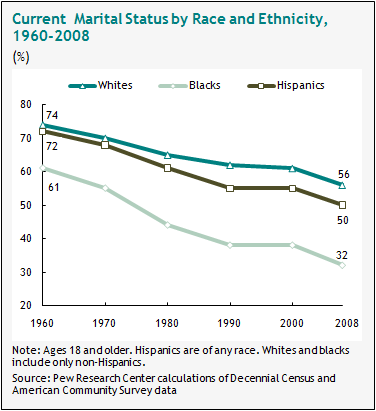
There are distinctive racial patterns in the changing attitudes and behaviors related to marriage and family. Marriage rates have fallen among whites, blacks and Hispanics over the past 50 years, but the drop has been most pronounced among blacks. In 1960, 61% of black adults were married. By 2008, that share had dropped to 32%. Among whites, the marriage rate dropped from 74% in 1960 to 56% in 2008. The trend in marriage rates among Hispanics has tracked more closely with that of whites. In 2008, 50% of Hispanic adults were married.
Blacks are more likely than whites to agree that marriage is becoming obsolete (44% vs. 36%). However, unmarried blacks are just as likely as unmarried whites to say they would like to get married in the future.
Race is also strongly linked to family living arrangements. In 2008, 27% of white adults and 33% of Hispanics were living with a spouse and one or more children. This compares with only 17% of black adults. Blacks are more likely to be single parents—living with one or more children but no spouse—than they are to be living with a spouse and raising children. In 2008, 19% of blacks were living in a household with children and no spouse.
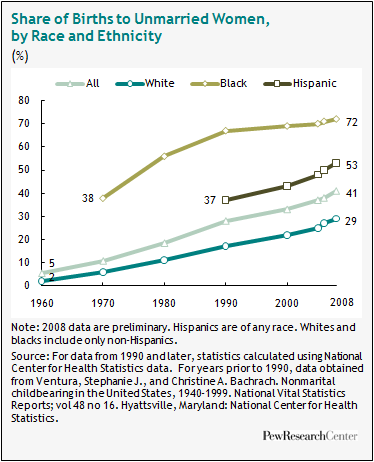
The trend in blacks’ living arrangements is driven in large part by the high incidence of out-of-wedlock births among black women. In 2008, seven-in-ten black women giving birth (72%) were unmarried. This compares with 53% of Hispanic women giving birth and 29% of whites.
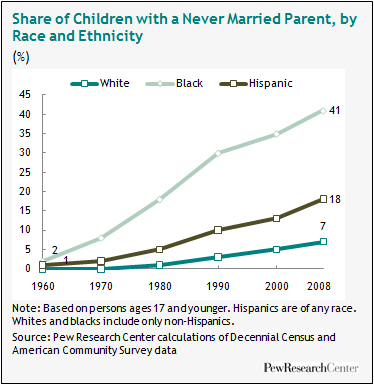
As a result, black children are much more likely than white or Hispanic children to live in a home with only one parent and to have a parent who has never been married. In 2008, roughly half of all black children under the age of 18 (52%) were living in a household with one parent. A third (32%) were in a household with two married parents. The rest were living in households with cohabiting partners (6%) or no parent at all (10%). By comparison, 74% of white children younger than age 18 lived in households with two married parents in 2008. Fewer than one-in-five (18%) lived in one-parent households, and the remainder lived with cohabiting partners (5%) or no parent (3%). Hispanic children fall in the middle: In 2008, 59% lived with two married parents, 27% lived with one parent, 9% lived with a cohabiting couple and 5% lived without a parent.
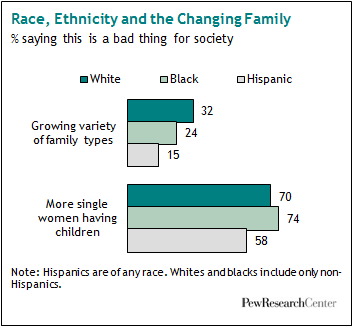
Because of the significant decline in marriage rates among blacks and the increase in out-of-wedlock births, the percentage of black children living with a parent who has never been married has grown dramatically over the past 50 years. In 1960, it was very rare for a child of any race or ethnicity to be living in a household with a parent who had never been married. Less than 1% of white children, 1% of Hispanic children and 2% of black children lived in this type of household. Since that time, the proportion of white and Hispanic children living with a parent who has never been married has risen steadily, reaching 7% among white children and 18% among Hispanic children in 2008. The increase has been much more pronounced among black children. By 2008, 41% of black children were living with a parent who had never been married.
Blacks have mixed views about the changes that have taken place in family structure in recent decades. Only one-in-four blacks (24%) say the growing variety in the types of family arrangements is a bad thing, compared with a third (32%) of whites. However, blacks are highly critical of the trend toward more single women having children without a male partner to help raise them. Three-quarters of blacks (74%) say this trend is bad for society. Whites are equally disapproving of this trend (70% say it’s a bad thing), while Hispanics are somewhat more receptive (58% consider it a bad thing).
Overall, blacks are less satisfied with their family life than are whites or Hispanics: 64% of blacks, compared with 79% of whites and 73% of Hispanics, say they are very satisfied with their family life.
Marriage, Family and Socio-Economic Status
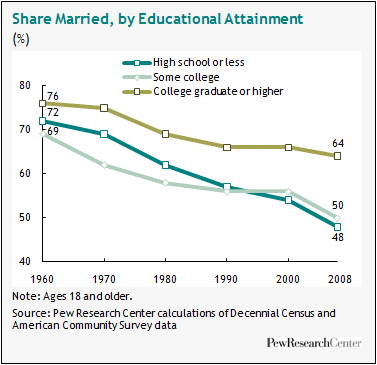
Socio-economic status can be measured in a variety of ways, but one rough proxy is educational attainment. Using this yardstick, the Pew Research report finds that the growing marriage gap in this country is aligned with a growing socio-economic gap.
In 1960, college graduates (76%) were only slightly more likely than those who never attended college (72%) to marry. By 2008, only 48% of those with a high school diploma or less were married, compared with 64% of college graduates. Recent analysis by the Pew Research Center showed that 2007 marked the first time that college-educated young adults were more likely than those without a college degree to have married by the age of 30.9
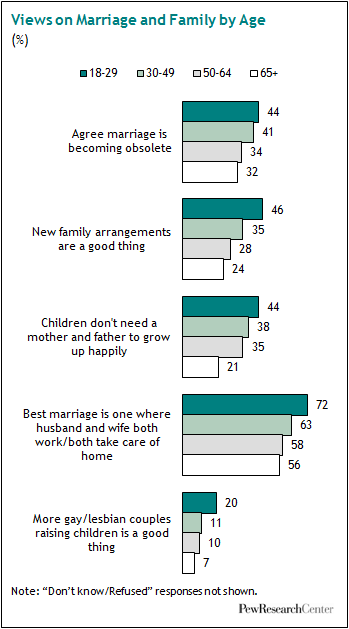
As a result of these changing marriage patterns, college graduates are now much more likely than those without a college degree to live in a traditional, 1950s-style family. In 2008, 35% of college graduates were living with a spouse and one or more children, compared with 23% of those with a high school education. The falloff over time in the percentage living in a more traditional family has been most dramatic among those with a high school education. In 1960, high school graduates (55%) were about as likely as college graduates (53%) to be living in a household with their spouse and children.
The Pew Research survey finds that college graduates are among the most likely to reject the notion that marriage is becoming obsolete: only 27% agree, while 71% disagree. Among those who have not gone to college, opinion is much more evenly split: 44% agree marriage is becoming obsolete, and 52% disagree.
The Generation Gap and Family Change
Attitudes about changing families also differ significantly by age. Younger Americans are much more open to the changes and more tolerant of alternative arrangements. In some cases, the age divide falls between those who are younger than 50 and those who are 50 and older. In other areas, the youngest generation, sometimes called the Millennials, stands out from all other age groups.
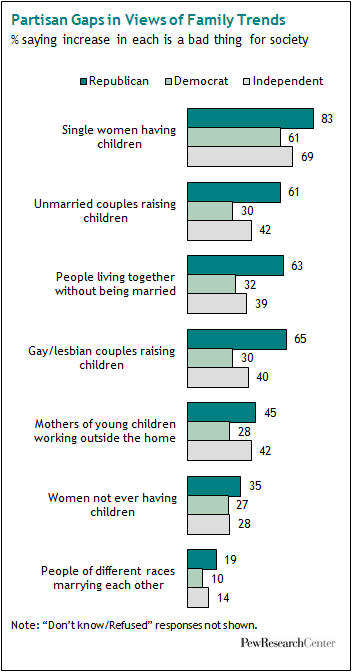
On the question of whether or not marriage is becoming obsolete, those younger than 50 (43%) are more likely than those ages 50 and older (33%) to agree.
The youngest adults—ages 18 to 29—are the most likely to favor a modern marriage, where both the husband and wife have jobs and both take care of the household and children, over the male breadwinner/female homemaker model that prevailed in the middle of the last century. More than seven-in-ten (72%) say the former is a more satisfying way of life. Only 22% would favor a marriage where the husband provides for the family and the wife takes care of the household and children.
Young adults are also much more open to new family arrangements. Nearly half of those younger than 30 (46%) say the growing variety of family arrangements is a good thing. This compares with 35% of those ages 30 to 49 and fewer than three-in-ten of those ages 50 and older.
Young adults differ from their elders in their views about the best family arrangements for children. Only about half agree with the idea that a child needs both a mother and a father to grow up happily, while 44% reject this notion. Older age groups tend to believe much more strongly in the two-parent ideal. In addition, young people are among the most supportive of gay and lesbian couples raising children. Of those younger than 30, 20% say this trend is a good thing. Among older age groups, only about half as many agree.
The Politics of Family Change
The growing “red-blue” divide in politics and government is also evident in attitudes and behaviors related to family.
For starters, Republicans and Democrats tend to live in different types of families. Two-thirds of Republicans (67%) are married, and 57% are married with children. Among Democrats, only 45% are married (38% are married with children). Democrats (9%) are twice as likely as Republicans (4%) to be living with a partner without being married. Among independents, 52% are married and 48% are unmarried.
Republicans and Democrats have much different perspectives on the changes that have taken place in families over the past 50 years. Nearly half of Republicans (48%) say the growing variety of family arrangements is a bad thing, while only 21% see this as a good thing and 26% say it doesn’t make a difference. Among Democrats, a 45% plurality say the growing variety of family types is a good thing; only 17% think this is a bad thing. An additional 35% say this doesn’t make a difference. Independents are more evenly split: 33% say this is a good thing, 27% say it’s a bad thing and 35% say it doesn’t make a difference.
When asked about specific trends in society that have affected families, Republicans are consistently more critical than Democrats. The biggest partisan gap is on the trend toward more gay and lesbian couples raising children. By a better than two-to-one margin, more Republicans (65%) than Democrats (30%) say this trend is bad for society. There are similarly large gaps in attitudes about more single women having children (83% of Republicans vs. 61% of Democrats say this is bad for society) and people living together without being married (63% of Republicans vs. 32% of Democrats say this is bad for society).
Republicans also take a much more negative view than do Democrats of the trends toward more single women having children and more mothers of young children working outside the home. The partisan gap is somewhat smaller though still significant on the trends toward more women not ever having children and more interracial marriages.
In most cases, the views of independents are closer to those of Democrats than Republicans. There are two exceptions. Independents are nearly as likely as Republicans to say more mothers of young children working outside the home is a bad thing. And when it comes to views on interracial marriage, independents fall squarely in the middle.
Republicans appear to have a stricter definition of family than do Democrats or independents. Survey respondents were presented with a variety of family arrangements and asked if each was a family or not. A majority of Democrats say each of the arrangements—from a married mother and father with children, to an unmarried couple living together with no children—is a family. Republicans, on the other hand, are reluctant to ascribe family status to certain groups.
For example, when asked whether a gay or lesbian couple living together with one or more children is a family, 46% of Republicans say it is, compared with 73% of Democrats. Similarly, while 32% of Republicans say a gay or lesbian couple living together with no children is a family, 56% of Democrats say the same. And one-in-four Republicans, compared with more than half of Democrats (54%), consider a cohabiting couple with no children to be a family.
Given the concern among Republicans about many of the societal trends affecting families, it is not surprising that they have a less positive outlook than Democrats on the future of the family. Fewer Republicans (63%) than Democrats (71%) say they are optimistic about the institution of marriage and the family.
Religion and the Family
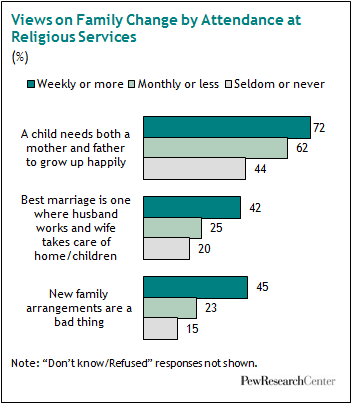
In addition to partisanship, religiosity is strongly linked to views on the family. Adults who attend religious services weekly or more often are much more resistant to the newer arrangements than are those who attend religious services less often or never. For example, among those who attend religious services at least once a week, 72% believe a child needs both a mother and a father to grow up happily. This compares with 62% of those who attend religious services monthly or a few times a year and 44% of those who seldom or never attend.
While a strong majority of the public favors a modern marriage where the husband and wife both have jobs and both take care of the household and children, many regular church attendees still favor a more traditional marriage. Among those who attend religious services once a week or more often, 42% say a marriage where the husband provides for the family and the wife takes care of the home and children is the more satisfying way of life. This compares with 25% of those who attend religious services occasionally and 20% who seldom or never attend.
It follows that those who attend religious services most often are among the most resistant to the growing variety of family arrangements. Nearly half (45%) of those who attend religious services weekly say the new family arrangements are a bad thing. Only one-in-five (19%) of those who attend religious services less frequently share that opinion.
Comparing the U.S. and Europe
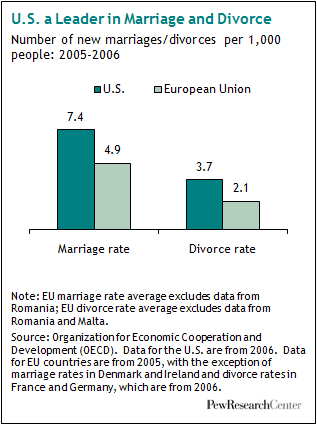
Americans have a unique relationship with marriage. Compared with most other western nations, the U.S. has one of the highest marriage rates as well as one of the highest divorce rates. According to data compiled by the Organization for Economic Cooperation and Development (OECD), there were more new marriages per 1,000 people in the U.S. in 2006 (7.4) than in any European Union (EU) country, with the exception of Cyprus, at a comparable time.10 In France and Italy, for example, just 4.2 new marriages were formed per 1,000 people in 2005, and the rate was even lower in the Eastern European countries of Hungary (4.1), Bulgaria (3.9) and Slovenia (3.2).
Though divorce rates have leveled off in this country, the U.S. continues to lead much of the western world in this area as well. In the mid-2000s, the number of divorces per 1,000 people in the U.S. was considerably higher than the average for EU countries (3.7 vs. 2.1).11 The divorce rate was especially low in Italy, where there was fewer than 1 divorce per 1,000 people (0.8). France and Germany fell in the middle of the EU pack, with divorce rates of 2.2 and 2.3, respectively, while former Soviet republics Lithuania (3.4 divorces per 1,000 people) and Latvia (3.3) had the highest divorce rates. (To some degree, of course, lower divorce rates in Europe are a by-product of lower marriage rates).
Cohabitation is less prevalent in the U.S. than in EU countries, especially those in Western Europe. According to data from 2000 compiled by the OECD, 5.5% of American adults ages 20 or older were cohabiting. By comparison, 8.7% of adults ages 20 and older in Great Britain, 9.3% in the Netherlands, and 11.8% in Finland were living with a partner early in the decade. In some parts of Europe, however, particularly in the south and east, cohabiting is much less common. For instance, only 1.3% of adults ages 20 and older in Poland and 1.4% in Slovakia were cohabiting early in the decade. In Italy, only 2% were cohabiting in 2001 as were 3.3% in Spain and 4.1% in Portugal.12
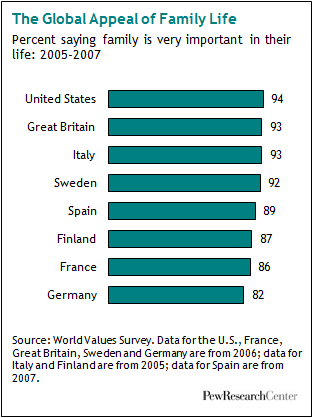
In his book, The Marriage Go-Round, Andrew Cherlin argues that Americans’ relatively high rates of marriage and divorce as well the short-term nature of their cohabiting relationships have all contributed to a great deal of instability in family life.13 For example, children in the U.S. are more likely than children in most western European countries to live in a household with only one parent. According to data from the U.S. Census Bureau, 25% of American children age 14 or younger were living with only one parent in 2008. The percentage of children living with one parent was slightly higher in Great Britain (30%) in 2007, but data compiled by the OECD suggests that the proportion was significantly lower throughout most of Western Europe. In France, 20% of children ages 14 and younger were living with one parent, as were 18% in Germany, 8% in Spain and Italy, and 5% in Finland.
In spite of the turbulent nature of marriage in the U.S., Americans are not willing to give up on the institution. When asked in a 2006 World Values Survey whether they agreed or disagreed that marriage is an out-dated institution, only 13% of Americans agreed. Nearly a third (32%) agreed with this statement in Spain, as did 20% in Germany and 18% in Italy.
When it comes to the importance of family life, Americans value it at least as much as citizens of other western nations. The 2006 World Values Survey asked respondents how important family is in their life – 94% of Americans said family is very important. Comparable proportions of respondents in Great Britain (93%), Italy (93%) and Sweden (92%) said family is very important in their life. The percentages were just slightly lower in Spain (89%), Finland (87%), France (86%), and Germany (82%).
Outcomes: Who Has the Most Satisfying Life?
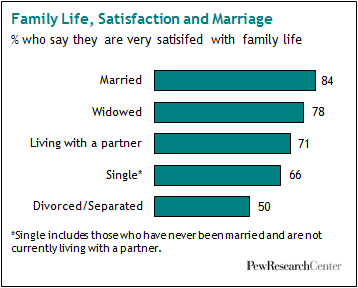
Amid the growing variety of family arrangements these days, one pattern is clear: Married people are more satisfied with their family lives than are unmarried people. Among married adults, 84% say they are very satisfied with their family life. This compares with 78% of those who are widowed, 71% of those who are living with a partner, 66% of those who are single14 and only half of those who are divorced or separated.
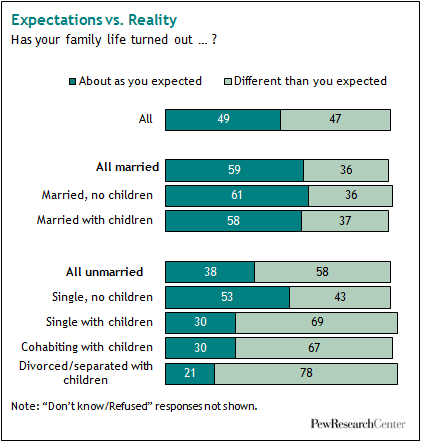
The presence of children in the household doesn’t have a significant impact on satisfaction with family life. Married adults with children (85%) are not significantly more satisfied than married adults without children (81%). And among single people who have never been married, those with children (64%) and those without children (67%) are equally likely to say they are very satisfied with their family life.
In addition to family type, race and ethnicity are correlated with family life satisfaction. More whites are highly satisfied with their family life (79% very satisfied) than blacks (64%) or Hispanics ( 73%).
Expectations
Life is full of surprises—and when it comes to family life, surprise correlates with family structure. Most adults living in less-traditional family arrangements say their family life has turned out differently than they expected, while most married adults say their family life has unfolded pretty much as they expected it would.
Among those who are married, whether or not they have children, roughly six-in-ten say their family life has turned out about as they expected. Among single adults with no children (most of whom are younger than 30), 53% say their family life has turned as they expected. It’s a much different story for single adults with children. Only 30% of them say their family life has turned out about as they expected. The vast majority (69%) say things have turned out differently than they expected. Similarly, among those who are living with a partner and raising children, only 30% say their family life has turned out as they expected, compared with 67% who say it’s been different from what they expected.
Not surprisingly, the end of a marriage is one of life’s most unexpected events. Among divorced or separated adults who are raising children, 78% say their family life has turned out differently from what they once envisioned.
Public Knowledge of Demographic Change
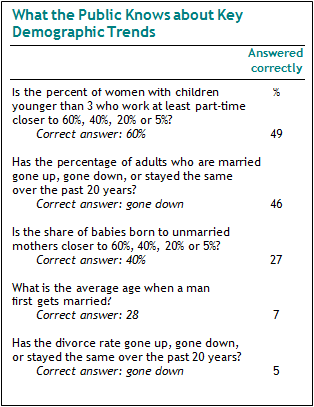
Given the pervasive impact of family change on American society, the public cannot help but be aware of the broad trends of the past half century. However, their familiarity with some of the details is limited. As part of our look at the changing American family, the Pew Research Center conducted a separate survey to measure knowledge of some key indicators.
The results were mixed. Roughly half of the respondents (46%) answered correctly that the percentage of American adults who are married has gone down over the past 20 years. One-in-ten said the marriage rate has gone up, 20% said it has stayed the same and 24% weren’t sure.
The public was much less knowledgeable about recent trends in divorce rates. Only 5% knew that the divorce rate has actually gone down over the past 20 years. Nearly two-thirds (66%) believed the divorce rate has gone up over the past two decades, 21% thought it has stayed the same, and 8% didn’t answer. The divorce rate did rise sharply during the 1960s and 1970s, before leveling off and beginning to decline.
The average age of first marriage has gone up gradually for both men and women. Respondents underestimated the average age at which a man gets married these days. The median age offered by respondents was 25; actually, the average is 28.
Answers to these three questions did not differ significantly by gender, race, age or education. However, when it came to questions about trends involving children, there were major differences across some of these demographic groups. Respondents were asked if they knew the share of babies currently born to unmarried mothers. They were offered four potential answers: 60%, 40%, 20% or 5%. Roughly a quarter (27%) correctly answered 40%, and another quarter estimated that it was even higher—60%.
Non-whites (40%) were more than twice as likely as whites (18%) to estimate that 60% of babies are born to unmarried mothers.15 Among whites, 30% gave the correct answer, compared with 12% of blacks.
Finally, the survey included a question about the percentage of women with children younger than 3 who are working either full time or part time. Roughly half of the public (49%) gave the correct answer—60%. Women (55%) were more likely than men (42%) to get this answer correct. In addition, more whites (52%) than non-whites (43%) correctly answered this question.




